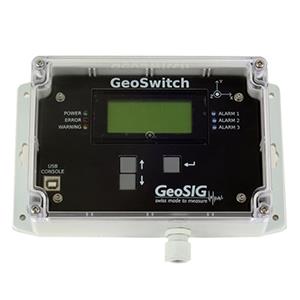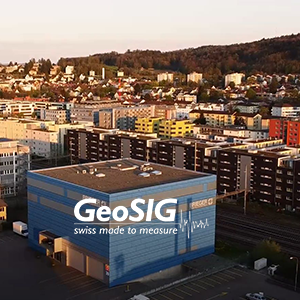GeoSIG scai slim - GMS series
Key Features
- Modular electronics for field repair and upgrade
- 3 or 6* channels, up to 2000 sps sampling rate
- Low noise individual 24-bit Δ−Σ ADC per channel
- External sensor options
- Wired, Wi-Fi*, GSM*, satellite* links
- Power-Over-Ethernet and wide power range
- Smart satellite* or network timing
- USB for storage and communication devices*
- Continuous data recording to ringbuffers
- Flexible configuration of multiple triggers
- Simultaneous data streaming to several clients
- Virtual signals from real-time processed sensor signal
- Added handles and gasket for improved portability
- Web Interface compatible with smartphones / tablets
- Simple and secure remote access over Internet
- Alarm output with up to 4 dry-contact relays*
- Low power consumption
- Hot swappable SD card, with easy access from the back (no screwdriver required)
- Third generation of NetQuakes Recorders
GeoSIG's latest offering— scai slim—is the groundbreaking latest generation of the GeoSIG Measuring Systems with highest performance, excellent operational flexibility and enhanced connectivity. With its optimized installation, operation and maintenance philosophy, scai slim offers the real possibility to measure any dynamic motion with an abundance of features and options.
Highly reduced cost of ownership and user-friendly approach in the design make scai slim the perfect choice for the most advanced user.
Numerous optimisations within the architecture and the design yields unprecedented performance for seamless and fast execution of all system processes.
scai slim is fully compatible with existing GeoSIG sensors and can co-exist and co-perform in the same network as the GMS series recorders. The simple upgrade path makes scai slim "future proof."
Housing is designed for easy transport, with handles and a gasket for better grip. Also, there is easy access to the SD card slot on the back, improving the user experience.
Applications
Highly reduced cost of ownership and user-friendly approach in the design make scai slim the perfect choice for the most advanced user.
Numerous optimisations within the architecture and the design yields unprecedented performance for seamless and fast execution of all system processes.
scai slim is fully compatible with existing GeoSIG sensors and can co-exist and co-perform in the same network as the GMS series recorders. The simple upgrade path makes scai slim "future proof."
Housing is designed for easy transport, with handles and a gasket for better grip. Also, there is easy access to the SD card slot on the back, improving the user experience.
Applications
- Seismic and Earthquake Recorder
- Structural Health Monitoring
- Real-time Seismology for Free-field and Urban Areas
- High Density Earthquake Monitoring Networks
- Shake / Hazard Mapping based on Instrumental Data
- Earthquake Early Warning and Rapid Response
- Damage Estimation, Disaster Management
- Seismic Alarm and Safe Shutdown
- Ambient Vibration Testing (optionally fully wireless)
- Induced Vibration Monitoring and Notification
- Building Code Compliant Instrumentation
-
Use and Versatility
- An intuitive web interface is available for easy configuration and interaction as well as display of live data graphs and state of health information, using any web browser.
- The device configuration file in XML format can be alternatively edited on site through the instrument console, exchanged by replacing the memory card, remotely from a server or through SSH from anywhere in the world.
- Modular plug-in electronics structure provides highly increased serviceability and maintenance as well as easy hardware field upgrades or replacements.
-
Data Analysis
- scai slim can perform realtime single/double integration, differentiation, HP/LP/BP filtering, decimation, peak/average calculations on the physical sensor signal and can provide these as realtime virtual signal. All recording and monitoring features can be applied on the virtual signals, simultaneous to the physical signals.
-
Sensor*
- External: All GeoSIG sensors and any other third-party sensors with following specifications can be connected to scai slim as external sensor(s):
- Sensor output:
- ±20 V, ±10 V, ±2.5 V - differential
- Software selectable
- Power to sensor:
- 15 or 24 VDC / 600 mA
-
Digitizer
- Channels:
- 3 or 6*
- A/D conversion:
- 24 bit Δ−Σ converters individual for each channel
- DSP:
- 32 bit output word length
- Dynamic range:
- Overall:
- 146 dB (per bin @ 1 Hz rel. full scale RMS)
137 dB @ 50 sps peak-peak RMS to RMS shorted input noise - Wide-band:
- 0 - 500 Hz
- 118 dB RMS full-scale peak to RMS shorted input noise
- ANSS:
- 0.002 - 50 Hz
- 127 dB RMS full-scale peak to RMS shorted input noise
- 0.01 - 15 Hz
- 132 dB RMS full-scale peak to RMS shorted input noise
- 15 - 30 Hz
- 133 dB RMS full-scale peak to RMS shorted input noise
- Sampling rate:
- configurable up to 6 channels @ 2000 sps;
supports 2 different simultaneous sample rates;
each channel can have different sampling rates - Max. bandwidth*:
- 0 to 1000 Hz
- Anti Aliasing Filter:
- Analog and digital FIR (finite impulse response)
-
Indicators
- LED Indicators:
- RGB LEDs for Power, System, Data, Network, and Sensor
-
Triggering
- Several Trigger Sets can be defined in the instrument. Each set can be flexibly configured regarding the source of trigger, main and advanced trigger parameters,
trigger processing and selected channels for storage. A voting logic based on the monitored channels can be defined. - Trigger Filter
- Fully independent high-, low- or bandpass trigger filters can be configured.
- Level Triggering
- Freely user adjustable threshold.
- STA / LTA Triggering
- Freely user adjustable STA / LTA values and STA/LTA trigger and de-trigger ratio.
- Scheduled / Manual
- After start-up, at a given date / time, after event or manual triggers.
- Early Warning (EEW)*
- JMA Earthquake Early Warning
-
Event Recording
- Pre-event memory:
- 1 to 720 seconds, typical
- Post-event duration:
- 1 to 7200 seconds, typical
-
Event Summary and Parameters
- Content:
- PGA, PGV, PGD, SA (at 0.3, 1, 3 Hz)
- Transmission delay:
- User defined from trigger time
-
Ring Buffer
- Usage:
- User can request an event from any period of the ring buffer by specifying the start time/date and the duration from the console or remotely from a server
- Method:
- Ringbuffer files with configurable duration which can be uploaded automatically to data server.
-
Data Stream
- Protocol/Compatibility:
- GSBU, SeedLink, compatible to Earthworm
-
Storage Memory
- Size and Type:
- 8 GByte Removable SD Card, FAT32 or EXT4 formatted
higher capacity on request* - Management:
- Intelligent management of memory card capacity using policies as per file type and ring buffer capacity specification.
- Recording format:
- miniSEED and extended miniSEED with information encapsulated into blockette 2000
- Estimated Capacity:
- Sampling rate [sps] x 0.4 [MB / day / 3 channel @ 100 sps]
(example: 40 MByte / day / 3 channel @ 100 sps)
typical, since the data is compressed, capacity depends on the context of the data. -
Self Test
- Permanent self monitoring of hardware and software components without affecting their normal operation.
- User-configurable periodical state of health (SOH) report based on comprehensive test of instrument, which can be requested at any time.
- User-configurable periodical sensor test.
- Advanced sensor testing with sine, saw and square wave injections.
- Logging of temperature and humidity inside the unit.
-
TimING
- Internal clock:
- Intelligent Adaptive Real Time Clock (IARTC)
- Sources:
- Network Time Protocol (NTP),
GNSS (GPS, GLONASS, BeiDou and Galileo) with external antenna
up to 5 m cable, or with external module up to 100 m cable*,
wired interconnection (ICC)* - Free running drift:
Without any source
- ±0.5 ppm @ constant +25 °C
±2.5 ppm @ -10 to +50 °C - After learn (source disconnect):
- < ±0.5 ppm @ -10 to +50 °C
- Accuracy:
- Running free:
- calculate from above drift
- Running with NTP:
- < ±0.5 ms
- Running with GPS or ICC:
- < ±0.5 ms
-
Power Supply
- Input voltage:
- 9 - 48 VDC
90 - 260 VAC / 50 - 60 Hz to 15 VDC
switched UL approved external power block* - Power over Ethernet:
- Mode A and B*
- Power consumption:
- 130 mA @ 12 VDC for 3 channels
200 mA @ 12 VDC for 6 channels -
Communication and connectivity
- Configuration, Data Retrieval°:
- Ethernet, Wi-Fi*, Serial line, Console, removable SD card, USB storage*
- Network requirements:
- Fixed or Dynamic IP on Ethernet LAN and/or internet connection with Ethernet interface
or OpenVPN, upload to HTTPS and SFTP servers, Wi-Fi
(b/g/n) network with WEP, WPA, WPA2 security and Enterprise Mode* - Security:
- GeoDAS proprietary protocol over SSL, checksum and software handshaking
- Connectors:
- Power, Ethernet, Multicom (USB and Serial RS-232), SD card*, Sensor(s)*, GPS*, Alarm*, Option*, Intercon*, Wi-Fi*, micro-USB console*
-
Alarm and Notification*
- This provides a seismic switch functionality. SMS notification is available*.
- Alarms:
- 4 independent solid state relay contacts for trigger alarm and/or error (user selectable). NO or NC contacts available.
With 1 acknowledge input. - Alarm levels:
- Freely user configurable based on event triggers
- Relay Hold-On:
- 1 to 60 seconds, typical; freely user configurable.
- Capacity:
- The contacts are suitable for a low voltage control. In case a large load must be switched then external relays should be implemented.
- Max voltage:
- 60 V / 250 mA per relay
-
Modem / WAN / LAN Interfaces*
- External peripheral modules for cellular 3G/4G, SHDSL, Fiber optic, etc, are available.
-
Environment / Reliability
- Operational temperature:
- -20 to +70 °C**
- Storage temperature:
- -40 to +85 °C**
- Humidity:
- 0 to 100 % RH (non-condensing)
- MTBF:
- > 500’000 hours (based on GMS series)
-
Housing
- Type:
- Aluminium housing
- Connectors:
- Metallic circular screwed, or MIL-style*
- Size:
- 275 x 190 x 100 mm (W x D x H)
- Weight:
- 3 kg
- Protection:
- IP65 (NEMA 4), IP68 (NEMA 6)*
- Easy Transport*:
- Handles for improved portability and mechanical protection of connectors.
-
GMSplus series are produced in different types to suit particular specifications or regulations. Specifications mentioned here may be different among different types.
* : Optional
** : Use of an internal battery may degrade this specification
° : Retrieved data can be in the following formats depending on transmission, software and storage method used: miniSEED, DAT, ASCII, SEISAN, SUDS, SAC, SEG-2, Matlab, Artemis
***Specifications subject to change without notice





































